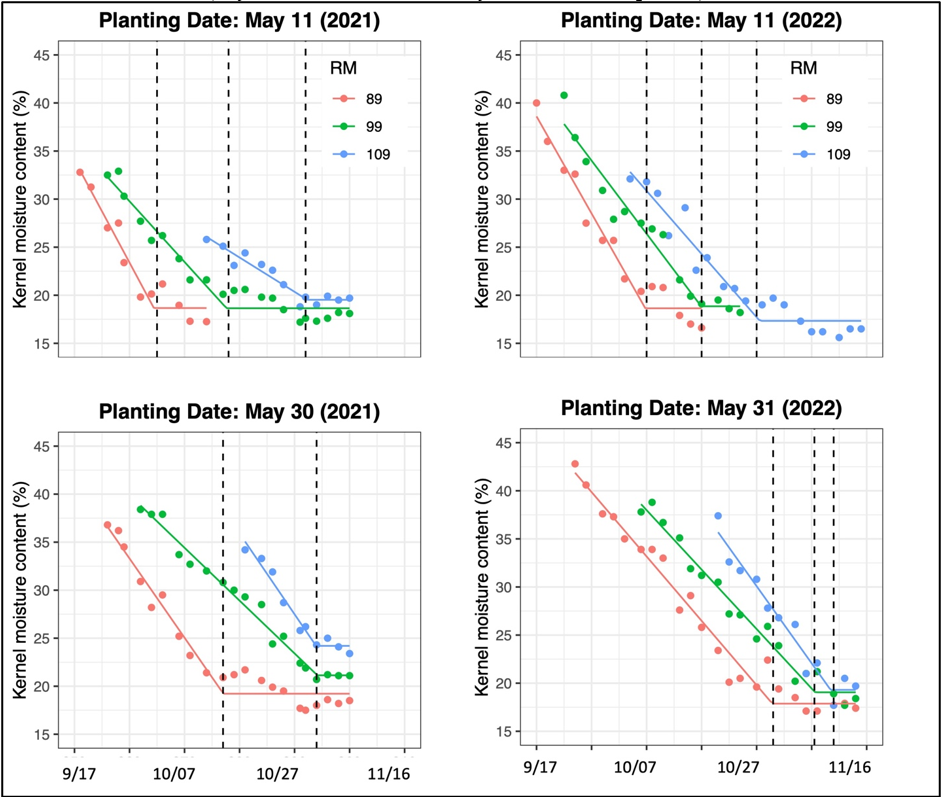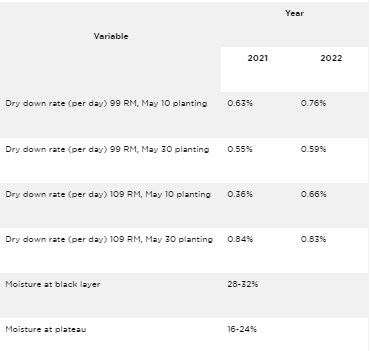By Benjamin Kwadwo Agyei and Jeffrey Andresen
Corn harvest decisions are dependent on kernel moisture content as it greatly affects drying costs (moisture price discount, drying fee and shrink factor) as well as the efficiency of harvest equipment. Therefore, obtaining sufficient in-field kernel dry down is crucial for maximum profit.
Weather elements including temperature, precipitation, solar radiation, humidity and wind greatly control how quickly kernels dry down in the field. Other factors such as ear angle, husk leaf senescence, husk leaf thickness and tightness, and husk leaf number also play significant roles.
Typically, the rate of dry down is more rapid when favorable environmental conditions coincide with corn maturation soon after kernels reach physiological maturity or black layer stage (i.e., maximum yield). Planting time and hybrid relative maturity have an impact on how quickly corn reaches black layer stage. Early planted corn hybrids mature more rapidly than late planted, with early-maturity hybrids often reaching black layer earlier than late-maturity hybrids.
Accurately estimating kernel dry down rates will be challenging this year because of the drought experienced earlier in the season, which might have delayed corn maturation. See “Corn growth and maturity response to variable weather conditions” from Michigan State University Extension for more information on corn maturity this year.
To help growers accurately estimate dry down rate to facilitate harvest decisions, we have provided data in this article for multiple corn hybrids (89, 99, 109 relative maturity) planted early May and late May in 2021 and 2022 from field trials conducted by the Cropping Systems Agronomy lab at Michigan State University in East Lansing, Michigan.
Figure 1 shows the daily dry down pattern of the three hybrids at each planting time in 2021 and 2022. Table 1 is the summary of the daily dry down rate, the moisture content at black layer, and the plateau moisture content (beyond which additional dry down is not expected).

Figure 1. Daily kernel dry down characteristics for three corn hybrids (89, 99 and 109 relative maturity, RM) and two planting dates (around May 10 and May 30) for two growing seasons (2021 and 2022). The vertical dotted lines represent plateau moisture content (kernel moisture content beyond which no significant dry down is expected).
Overall, similar dry down patterns and rates were observed in both years, but the rate of dry down was numerically higher in 2022. Over both years, kernel drying rate averaged 0.70% for 99 relative maturity and 0.51% for 109 relative maturity hybrid planted in early May. For end of May planting, dry down averaged 0.57% for 99 relative maturity and 0.84% for 109 relative maturity hybrid.
In general, kernel dry down for late-planted and late-maturity hybrids reached plateau moisture content by late October. Plateau moisture content is the kernel moisture beyond which no considerable amount of additional dry down occurs. In 2021, plateau moisture content for late-planted hybrids was greater than 20% and we did not observe additional dry down due to lack of favorable environmental conditions (persistent cool, wet weather), hence final harvested corn was greater than 5% above the 15.5% threshold. However, in 2022, plateau moisture content was much lower (around 18%) and a period of abnormally warm and dry weather in early November provided extra drying with final harvest moisture around 16%. Harvesting corn at 5% beyond threshold can significantly reduce profit.

What number should you use to estimate dry down this year?
Abnormally warm and dry weather led to excellent drying conditions during the final week of September and the first week of October across much of Michigan this year. The rate of drying in fields with mature corn likely exceeded 0.7% per day. However, according to the United States Department of Agriculture's crop progress report for Michigan published Oct. 2, just 35% of corn fields had reached maturity, which is a decrease of 18% from 2022 and 20% behind the five-year average. This means some corn will be late in reaching maturity.
The outlook for October is expected to be favorable for further drying, and while some periods of relatively cool and wet weather (and slow drying) are likely, the month is forecast to average out warmer and drier than normal. If that's the case, late maturing corn could dry down as much as 0.7% per day and might still lose some moisture into early November.
Source : msu.edu